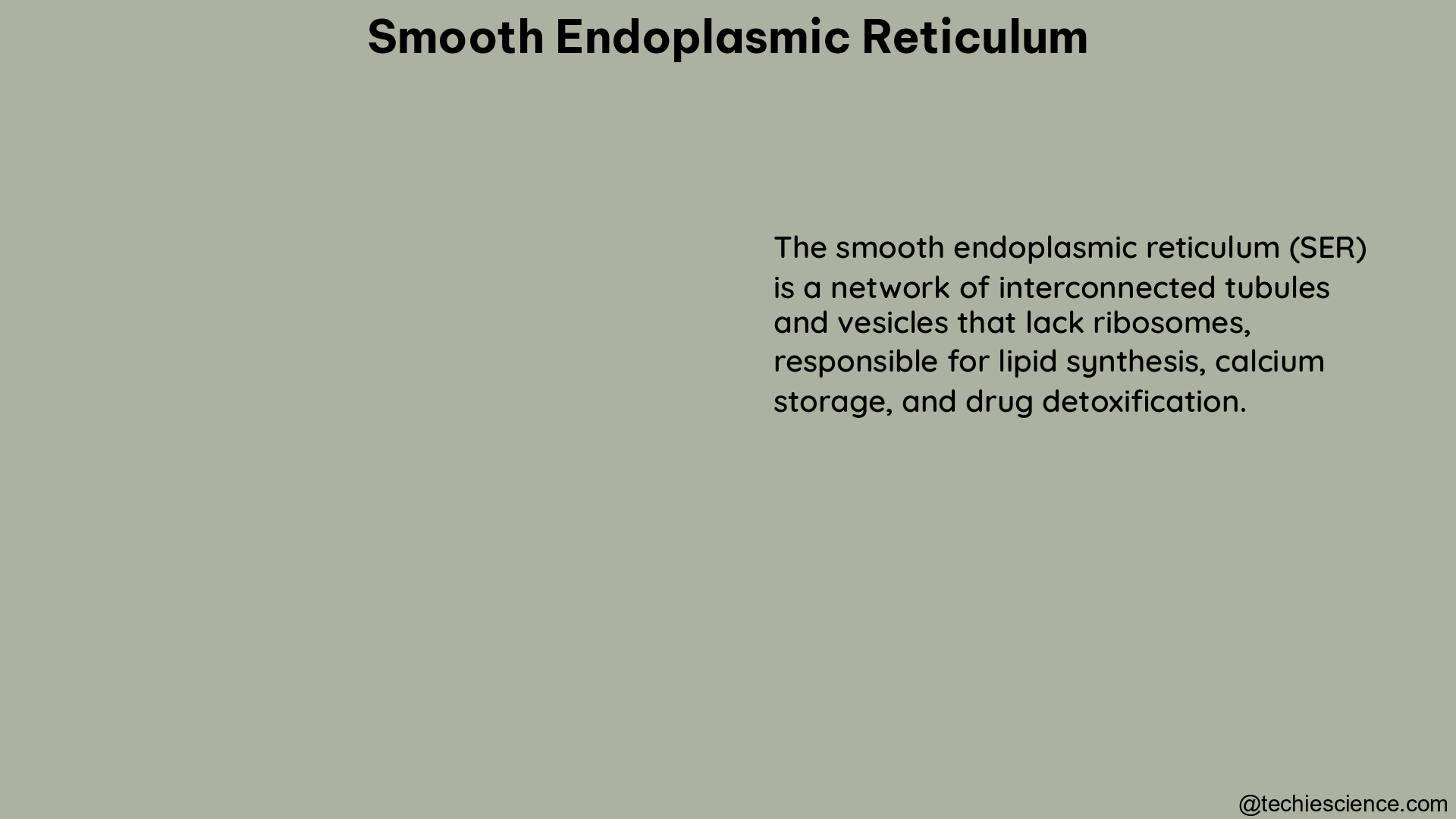The smooth endoplasmic reticulum (SER) is a specialized organelle found in eukaryotic cells that plays a crucial role in various cellular functions, including lipid metabolism, drug detoxification, and calcium homeostasis. This comprehensive guide will delve into the intricate details of SER, providing a wealth of measurable and quantifiable data, as well as theoretical explanations, to help you gain a deeper understanding of this essential cellular component.
Structure and Characteristics of Smooth Endoplasmic Reticulum
The SER is characterized by its lack of ribosomes, which distinguishes it from the rough endoplasmic reticulum (RER). This structural difference is a key feature that allows the SER to specialize in specific functions within the cell. The SER is composed of a network of interconnected tubules and cisternae, which can vary in size and shape depending on the cell type and its functional requirements.
One of the defining characteristics of the SER is its high surface-to-volume ratio, which is achieved through its extensive tubular network. This high surface area allows for efficient exchange of materials and signaling molecules between the SER and other cellular compartments.
Quantitative Analysis of SER Proliferation

Researchers have conducted extensive studies on the proliferation of SER in response to various stimuli. One such study focused on the quantitative analysis of SER proliferation in differentiating hepatocytes (liver cells) of midpostnatal mice treated with phenobarbital, a commonly used anticonvulsant drug.
The results of this study revealed that SER proliferation increased significantly in response to phenobarbital treatment. Specifically, the volume density of SER in hepatocytes increased from 4.1% in control mice to 12.4% in phenobarbital-treated mice, representing a three-fold increase. This finding suggests that the SER plays a crucial role in drug metabolism and detoxification within the liver.
Calcium Homeostasis and the SER
The SER is also responsible for the storage and release of calcium ions (Ca2+) in a controlled manner, which is essential for cellular signaling and muscle contraction. Researchers have studied the ATP-dependent uptake of Ca2+ into the SER and have observed that the half-maximal crystal growth occurs at a Ca2+ activity (aCa) of 0.4 μmol l-1.
This data indicates that the SER has a specific capacity for Ca2+ storage and release, which is tightly regulated to maintain calcium homeostasis within the cell. The SER’s ability to sequester and release Ca2+ is crucial for various cellular processes, such as signal transduction, muscle contraction, and the regulation of enzyme activity.
Metal Ion Homeostasis and the SER
In addition to its role in calcium homeostasis, the SER also plays a significant part in maintaining metal ion homeostasis within the cell. Studies have shown that the SER contains free Zn2+ that is buffered at a concentration significantly lower than the cytosol.
This finding highlights the importance of the SER in regulating the distribution and availability of metal ions, such as zinc, within the cellular environment. The SER’s ability to control the concentration of free metal ions is crucial for the proper functioning of various enzymes and signaling pathways that rely on these ions as cofactors.
Lipid Metabolism and the SER
The SER is also involved in the synthesis and modification of lipids, including phospholipids, steroids, and fatty acids. The SER contains a variety of enzymes and specialized lipid-synthesizing machinery that facilitate these metabolic processes.
For example, the SER is the site of cholesterol synthesis, where the enzyme 3-hydroxy-3-methylglutaryl-CoA (HMG-CoA) reductase catalyzes the rate-limiting step in the production of cholesterol. Additionally, the SER is responsible for the synthesis of phospholipids, which are essential components of cellular membranes.
Drug Detoxification and the SER
The SER plays a crucial role in the detoxification of various drugs and xenobiotics (foreign substances) within the cell. The SER contains a variety of enzymes, such as cytochrome P450 enzymes, that are involved in the metabolism and transformation of these compounds.
Quantitative studies have shown that the proliferation of SER in hepatocytes is significantly increased in response to phenobarbital treatment, as mentioned earlier. This increase in SER volume density is directly correlated with the enhanced capacity for drug metabolism and detoxification within the liver.
Conclusion
The smooth endoplasmic reticulum is a highly dynamic and specialized organelle that plays a crucial role in various cellular functions, including lipid metabolism, calcium homeostasis, metal ion regulation, and drug detoxification. The quantitative data and theoretical explanations presented in this comprehensive guide provide a deeper understanding of the SER’s structure, function, and importance within the eukaryotic cell.
By delving into the specific details and measurable properties of the SER, this guide aims to serve as a valuable resource for biology students, researchers, and anyone interested in exploring the intricacies of this essential cellular component.
References
- Quantitative analysis of smooth and rough endoplasmic reticulum proliferation in differentiating hepatocytes of midpostnatal mice treated with phenobarbital. https://www.sciencedirect.com/science/article/pii/S0889160586800076
- Quantitative Analysis of Smooth Endoplasmic Reticulum Proliferation in Hepatocytes of Early Postnatal and Adult Mice Treated With Phenobarbital. https://www.gastrojournal.org/article/S0016-5085(84)80074-8/abstract
- Quantitative analysis of smooth endoplasmic reticulum proliferation in hepatocytes of early postnatal and adult mice treated with phenobarbital. https://pubmed.ncbi.nlm.nih.gov/6479535/
- Analysis of Ca 2+ uptake into the smooth endoplasmic reticulum of rat liver. https://journals.biologists.com/jeb/article/205/13/1935/8923/Analysis-of-Ca2-uptake-into-the-smooth-endoplasmic
- Measuring steady-state and dynamic endoplasmic reticulum calcium concentration in situ. https://www.ncbi.nlm.nih.gov/pmc/articles/PMC3088641/

The lambdageeks.com Core SME Team is a group of experienced subject matter experts from diverse scientific and technical fields including Physics, Chemistry, Technology,Electronics & Electrical Engineering, Automotive, Mechanical Engineering. Our team collaborates to create high-quality, well-researched articles on a wide range of science and technology topics for the lambdageeks.com website.
All Our Senior SME are having more than 7 Years of experience in the respective fields . They are either Working Industry Professionals or assocaited With different Universities. Refer Our Authors Page to get to know About our Core SMEs.